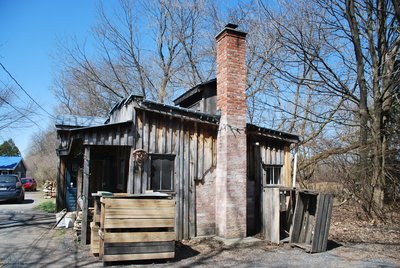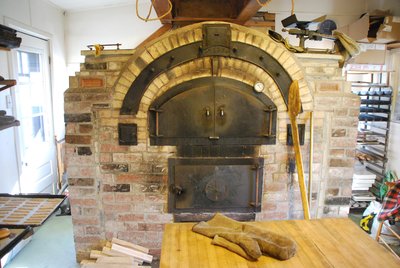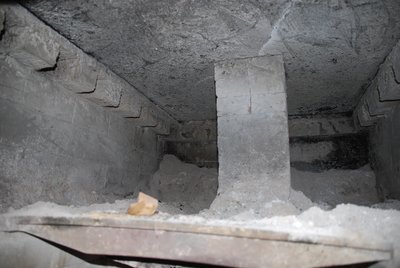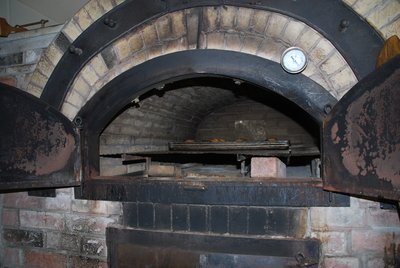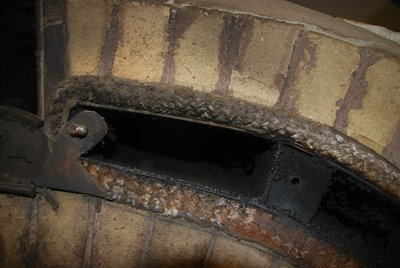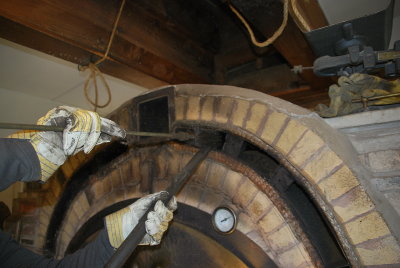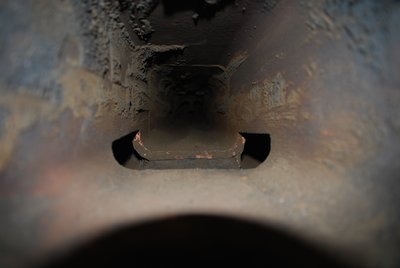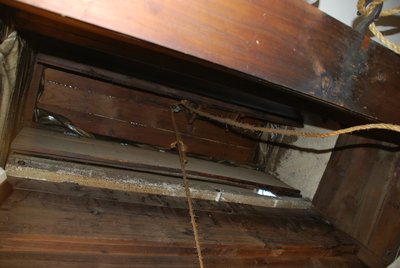Cleaning The Oven Of Philip Baker In Stanbridge East
This is an indirect fired oven. The fire box being located directly below the bake chamber. The bake chamber consists of 2 parallel vaults which form a 2.5 inch wide channel between themselves. Gases flow from the fire box via 2 manifolds, one on ether side of the fire box, into the channel, and then up to the collector which runs from front to back of the vault, where it connects to the chimney. The collector also acts as a key, having both sides of the exterior vault spring onto it.
The fire box is extremely large and runs beneath the whole length of the oven's hearth. The fire box sealing forms the oven's hearth and consists of a monolithic 4 inch thick, pre-cast, refractory concrete slab.
The openings in the manifold between the corbel, along the top course of either side of the fire box, allow gases to flow up each side of the channel between the two vaults.
A masonry pillar supports the hearth slab.
The openings in the manifold between the corbel, along the top course of either side of the fire box, allow gases to flow up each side of the channel between the two vaults.
A masonry pillar supports the hearth slab.
Note: The oven was designed and built by someone with no experience building ovens. Due to the size of the fire box and orientation of the smoke path, the ovens hearth initially becomes way hotter than the vault, and so all baking is done upon a steel grill which lifts the bake load closer to the vault, and keeps it from contacting the hearth. Once stabilised several hours after firing, the discrepancy between hearth and vault is negligible.
With the access doors open and cover plate removed, the channel between the two vaults can be cleaned. The square opening at the bottom right gives access to the manifold on the right side of the fire box. The square opening at top left, gives access to the collector, and chimney connection. The curved opening gives access to the channel between the vaults, running from the manifold to the collector.
The channel between the vaults is so encrusted with carbon and fly ash that it has started to weaken the draw.
The collector runs from the front to rear of the vault and on to the chimney which is located behind the oven. The collector is formed from 8 x 8 inch clay flue tiles and has two 6x6 inch openings in the bottom of the channel, allowing gases that travel up through the channel between the vaults, to enter the collector. One of these openings is to the rear and one at the front. The rear opening is closed off with an adjustable steel plate. The plate slides along the bottom of the channel, but cannot be adjusted without opening the access door. The shut off plate handle is seen here protruding from the collector, as it is being removed for cleaning. The oven functions best with the opening in the rear of the collector fully closed. Having the second opening and shut off plate give more potential flexibility, in terms of balancing the draw, and using the opening as a more direct rout to the chimney if ever the oven is fired from cold.
The shut off plate lies loose in the bottom of the collector, and is held in position by its own weight. The two log sides of the plate are bent at right angles to ensure full closure of the opening, which is cut through the shoulder of the flue tile that forms the collector.
The collector after cleaning. Note the opening in the bottom of the channel. The second opening, at the back of the vault, is about 2 feet further along the collector, and not visible in this image.
View up the channel that runs between the vaults. Gases flow from the manifold, out of view bottom right, to the opening in the front of the collector, centre left.
Grind Slowly Moudre Fin in Stanbridge East
Sweet Men Of Stanbridge East
Marcus Flynn
2017
